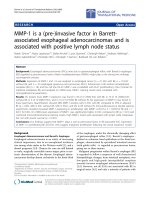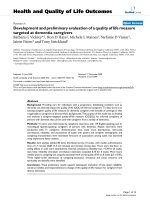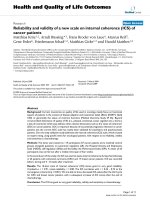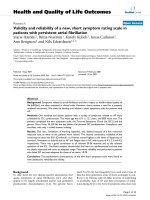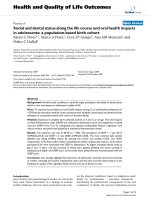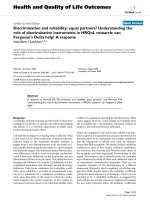báo cáo hóa học: " Microglia and neuroinflammation: a pathological perspective" potx
Bạn đang xem bản rút gọn của tài liệu. Xem và tải ngay bản đầy đủ của tài liệu tại đây (236.12 KB, 4 trang )
BioMed Central
Page 1 of 4
(page number not for citation purposes)
Journal of Neuroinflammation
Open Access
Review
Microglia and neuroinflammation: a pathological perspective
Wolfgang J Streit*
1
, Robert E Mrak
2
and W Sue T Griffin
3
Address:
1
Department of Neuroscience, University of Florida College of Medicine, P.O. Box 100244, Gainesville, Florida 32610, USA,
2
Department
of Pathology, University of Arkansas for Medical Sciences, Little Rock, Arkansas 72205, USA and
3
Department of Geriatrics, University of Arkansas
for Medical Sciences and GRECC/CAVHS, Little Rock, Arkansas 72205, USA
Email: Wolfgang J Streit* - ; Robert E Mrak - ; W Sue T Griffin -
* Corresponding author
Abstract
Microglia make up the innate immune system of the central nervous system and are key cellular
mediators of neuroinflammatory processes. Their role in central nervous system diseases, including
infections, is discussed in terms of a participation in both acute and chronic neuroinflammatory
responses. Specific reference is made also to their involvement in Alzheimer's disease where
microglial cell activation is thought to be critically important in the neurodegenerative process.
Background
A role for immune responses, involving antigen presenta-
tion and immune-response-generating cytokines, in neu-
rodegenerative diseases such as Alzheimer's disease was
recognized for a decade before the term neuroinflamma-
tion came into widespread use [1,2]. A PubMed search
using "neuroinflammation" as the only key word yields
some 300 papers, none before 1995 [3]. While some
chronic/remitting neurological diseases, such as multiple
sclerosis, have long been recognized as inflammatory, the
term neuroinflammation has come to denote chronic,
CNS-specific, inflammation-like glial responses that do
not reproduce the classic characteristics of inflammation
in the periphery but that may engender neurodegenerative
events; including plaque formation, dystrophic neurite
growth, and excessive tau phosphorylation. In this way,
neuroinflammation has been implicated in chronic unre-
mitting neurodegenerative diseases such as Alzheimer's
disease – diseases that historically have not been thought
of as inflammatory diseases. This new understanding has
come from rapid advances in the field of microglial and
astrocytic neurobiology over the past fifteen to twenty
years. These advances have led to the recognition that glia,
particularly microglia, respond to tissue insult with a
complex array of inflammatory cytokines and actions, and
that these actions transcend the historical vision of phago-
cytosis and structural support that has long been
enshrined in the term "reactive gliosis." Microglia are now
recognized as the prime components of an intrinsic brain
immune system [4], and as such they have become a main
focus in cellular neuroimmunology and therefore in neu-
roinflammation. This is not the inflammation of the
adaptive mammalian immune response, with its array of
specialized T-cells and the made-to-order antibodies pro-
duced through complex gene rearrangements. This is,
instead, the innate immune system, upon which adaptive
immunity is built [5].
Many researchers now consider this innate immune
response in the brain to be a potentially pathogenic factor
in a number of CNS diseases that lack the prominent leu-
kocytic infiltrates of adaptive immune responses, but that
do have activated microglia and astrocytes, i.e., neuroin-
flammation.
Published: 30 July 2004
Journal of Neuroinflammation 2004, 1:14 doi:10.1186/1742-2094-1-14
Received: 08 July 2004
Accepted: 30 July 2004
This article is available from: />© 2004 Streit et al; licensee BioMed Central Ltd.
This is an open-access article distributed under the terms of the Creative Commons Attribution License ( />),
which permits unrestricted use, distribution, and reproduction in any medium, provided the original work is properly cited.
Journal of Neuroinflammation 2004, 1:14 />Page 2 of 4
(page number not for citation purposes)
The idea that neuroinflammation is detrimental implies
that glial cell activation precedes and causes neuronal
degeneration [2], a sequence of events that appears to be
at odds with experimental models of neurodegeneration
in which glial cell activation occurs secondary to neuronal
damage. What is missing from this simple linear model is
the understanding that chronic neurological diseases are
just that – chronic, and that this chronicity introduces
complex interactions and feedback loops between neu-
rons and glia that render attempts to construct simple, lin-
ear cascades of cause and effect inelegant.
In the following, we provide some basic definitions and
discussion to more precisely define the idea of neuroin-
flammation as a CNS tissue response to injury, and the
notion of neuroinflammation as a pathogenic factor in
neurodegenerative diseases.
Some basic definitions
Inflammation is a reaction of living tissues to injury [6].
The discipline of pathology makes a fundamental distinc-
tion between acute and chronic inflammation. Acute
inflammation comprises the immediate and early
response to an injurious agent and is basically a defensive
response that paves the way for repair of the damaged site.
Chronic inflammation results from stimuli that are per-
sistent. In the periphery, inflammation consists of leuko-
cytic infiltrates characterized by polymorphonuclear cells
(neutrophils) in acute inflammation and mononuclear
cells (macrophages, lymphocytes, plasma cells) in chronic
inflammation. In order to validate these principles of gen-
eral pathology within the context of neuroinflammation,
one must obviously consider both acute and chronic neu-
roinflammation and, therefore, these are addressed sepa-
rately in the following sections.
Acute neuroinflammation
Before "neuroinflammation" became a commonly used
term, neuroscientists spoke of "reactive gliosis" in describ-
ing endogenous CNS tissue responses to injury. Reactive
gliosis specifically referred to the accumulation of
enlarged glial cells, notably microglia and astrocytes,
appearing immediately after CNS injury has occurred. In
contrast to glial reactivity, which suggests a largely passive
response to injury; glial activation implies a more aggres-
sive role in responding to activating stimuli: activated glial
cells release factors that act on and engender responses in
target cells analogous to the responses of activated
immune cells in the periphery. Activation of immune cells
in the periphery leads to leukocyte infiltration of tissues,
but this is notably absent in the brain unless there has
been destruction or compromise of the blood brain bar-
rier [7,8]. In the presence of such destruction or compro-
mise, peripheral leukocytes do enter the brain producing
a scenario similar to that seen in inflammatory responses
in the periphery.
In limited, acute reactions to injury, in the absence of
blood-brain barrier breakdown, there is the subtler
response of the brain's own immune system, composed
largely of rapid activation of glial cells. These responses
represent the other end of the spectrum of CNS injury,
where limited neuronal insults trigger glial cell activation
without breakdown of the blood brain barrier and with-
out concomitant leukocytic infiltration. This form of
"pure" glial response occurs in neuronal injury caused by
either loss of afferents [9] or loss of efferents [10]. Axot-
omy, for instance, results in neuronal chromatolysis, the
classic example of potentially reversible neuronal injury
[9]. It is in these situations that microglial and astrocytic
responses (like their peripheral counterparts) fulfill their
evolutionarily programmed functions of a reparative
response to the benefit of the organism as a whole.
Although such specific responses might, in a strict sense,
be included in the term "neuroinflammation," neuroin-
flammation as generally used and understood applies to
more chronic, sustained cycles of injury and response, in
which the cumulative ill effects of immunological micro-
glial and astrocytic activation contribute to and expand
the initial neurodestructive effects, thus maintaining and
worsening the disease process through their actions.
Chronic neuroinflammation
The concept of chronic inflammation (as opposed to
acute inflammation) is more relevant in the context of
understanding CNS disease (as opposed to CNS injury),
as the very term "disease" implies chronicity. Chronic
multiple sclerosis is, of course, an unequivocal and long-
recognized example of an inflammatory brain disease.
Although the underlying cause(s) of multiple sclerosis
have not been elucidated, it is probably safe to say that the
persistent injurious stimulus that accounts for neuroin-
flammation in multiple sclerosis is a myelin-related pro-
tein that has escaped self-tolerance and become an
autoimmunogen. Consistent with the chronic persistence
of this autoimmunogen is a persistent accumulation of
blood-derived mononuclear leukocytes in the CNS paren-
chyma, a phenomenon that is similar to what is found in
other autoimmune diseases such as rheumatoid arthritis
or polymyositis.
Infections are another group of diseases that are classically
recognized as inflammatory in nature, with meningeal,
perivascular, or even parenchymal infiltrates of peripheral
leukocytes. There are, however, exceptions. Rabies is a dis-
ease in which the peripheral immune response is slow and
inadequate, and in which classic inflammatory changes
are less striking than those found in other viral encepha-
Journal of Neuroinflammation 2004, 1:14 />Page 3 of 4
(page number not for citation purposes)
lidites. Babes, in 1897 [11], described microglial activa-
tion in rabies infection, although he did not recognize the
nodules he found as clusters of activated microglia. Simi-
lar small collections of activated microglia were subse-
quently found to occur in a wide variety of viral brain
infections.
Today, the most important example of a chronic brain
infection is human immunodeficiency virus (HIV).
Chronic HIV encephalitis is characterized by the same
nodules of activated microglia that Babes described in
rabies. HIV enters and persists in the CNS via myelo-
monocytic cells: monocytes, perivascular cells, and micro-
glia [12]. HIV infection is uniquely different from most
other infectious diseases affecting the CNS in that the
virus targets and disables precisely those cells that are key
players in neuroinflammation; microglia in the brain and
T lymphocytes in the periphery. It therefore comes as no
surprise that prominent T cell infiltrates do not occur in
HIV encephalopathy.
Prion diseases represent another chronic infectious CNS
disease that is not accompanied by leukocytic infiltrates.
Microglial activation, again, appears to be the most prom-
inent inflammatory component of prion diseases [13,14],
although there are a few reports describing T cell infiltra-
tion as well [15,16]. Prion diseases share interesting paral-
lels to rabies infection in that infected cells are
unrecognized by peripheral immune responses. This may
explain in part the unusual patterns of neuroinflamma-
tion in prion diseases – manifest not only in atypical cel-
lular infiltrates but also in unusual cytokine profiles [17].
Both HIV and prion infections probably produce an
altered microglial physiology that is likely to translate into
cycles of neurodegeneration, which could be a contribut-
ing factor in the development of dementia that occurs in
these conditions.
Chronic microglial neuroinflammation in
neurodegenerative diseases
Neurodegenerative diseases – particularly Alzheimer's dis-
ease, but also amyotrophic lateral sclerosis, Parkinson's
disease, and Huntington's disease – lack the prominent
infiltrates of blood-derived mononuclear cells that charac-
terize autoimmune diseases. On the other hand, there is
abundant evidence that many substances involved in the
promotion of inflammatory processes are present in the
CNS of patients with such neurodegenerative diseases. By
far the bulk of this body of evidence is related to studies
in Alzheimer's disease [18]. What distinguishes Alzhe-
imer's disease from other neurodegenerative diseases is
the conspicuous presence of extracellular deposits of amy-
loid in senile plaques. Senile plaques in Alzheimer brain
are present in different stages of maturity, ranging from
diffuse to neuritic to dense core, but they all contain the
amyloid beta protein (Aβ). Aβ is a peptide that forms
insoluble and pathological extracellular aggregates that
seem to attract microglial cells, as suggested by the cluster-
ing of microglia at sites of Aβ deposition (see [19] for a
review). There is evidence from experimental studies in
animals to support the idea that microglia can phagocy-
tose and degrade amyloid [20,21], but such phagocytosis
is apparently either ineffective or inadequate in Alzhe-
imer's disease. A key question within the current context
is: "Does the amyloid in Alzheimer brain by itself repre-
sent a persistent injurious stimulus that causes neuronal
injury, or are additional factors involved in eliciting this
outcome?" Direct injection of Aβ into the brain produces
activation of microglia and loss of specific populations of
neurons [21]. Furthermore, transgenic mice that overex-
press human, mutant β-amyloid precursor protein (βAPP)
do develop Aβ deposits with associated evidence of neu-
ritic injury (although they do not develop Alzheimer-type
neurofibrillary tangles unless they are also transgenic for
human tau protein) [22]. These Aβ deposits, born of
transgenic overexpression of mutant human amyloid pre-
cursor protein, invariably contain activated microglia
[22,23].
β-Amyloid precursor protein βAPP functions as a neuro-
nal acute-phase, injury-response protein. For instance,
there is excessive expression of βAPP, accompanied by
microglial activation and cytokine expression, after trau-
matic head injury [24]. With head injury, there is also Aβ
deposition, both in experimental animals [25] and in
humans – particularly in individuals genetically suscepti-
ble for AD (i.e. ApoE ε4-positive) [26]. These observations
emphasize the complex interactions that underlie neuro-
degeneration in Alzheimer's disease.
Conclusions
Chronic microglial activation is an important component
of neurodegenerative diseases, and this chronic neuroin-
flammatory component likely contributes to neuronal
dysfunction, injury, and loss (and hence to disease pro-
gression) in these diseases. The recognition of microglia as
the brain's intrinsic immune system, and the understand-
ing that chronic activation of this system leads to patho-
logic sequelae, has led to the modern concept of
neuroinflammation. This vision of microglia-driven neu-
roinflammatory responses, with neuropathological con-
sequences, has extended the older vision of passive glial
responses that are inherent in the concept of "reactive
gliosis."
Abbreviations
Aβ: β-amyloid peptide
βAPP: Aβ precursor protein
Publish with Bio Med Central and every
scientist can read your work free of charge
"BioMed Central will be the most significant development for
disseminating the results of biomedical research in our lifetime."
Sir Paul Nurse, Cancer Research UK
Your research papers will be:
available free of charge to the entire biomedical community
peer reviewed and published immediately upon acceptance
cited in PubMed and archived on PubMed Central
yours — you keep the copyright
Submit your manuscript here:
/>BioMedcentral
Journal of Neuroinflammation 2004, 1:14 />Page 4 of 4
(page number not for citation purposes)
CNS: central nervous system
HIV: human immunodeficiency virus
MS: multiple sclerosis
Competing interests
None declared
Authors' contributions
WJS conceived this review, wrote the initial draft, modi-
fied this with the comments of REM and WSTG, and wrote
the final draft. REM and WSTG contributed particularly to
the sections on infections and on Alzheimer's disease. All
authors read and approved the final version.
Acknowledgments
Supported in part by NIH R21 NINDS 049185, NIH PO1 AG 12411, NIH
P30 AG 19606, NIH RO1 AG 37989, and the McKnight Brain Research
Foundation at the University of Florida.
References
1. McGeer PL, Itagaki S, Tago H, McGeer EG: Reactive microglia in
patients with senile dementia of the Alzheimer type are pos-
itive for the histocompatibility glycoprotein HLA-DR. Neuro-
sci Lett 1987, 79:195-200.
2. Griffin WST, Stanley LC, Ling C, White L, MacLeod V, Perrot LJ,
White CL III, Araoz C: Brain interleukin 1 and S-100 immuno-
reactivity are elevated in Down syndrome and Alzheimer
disease. Proc Natl Acad Sci U S A 1989, 86:7611-7615.
3. Issazadeh S, Mustafa M, Ljungdahl A, Hojeberg B, Dagerlind A, Elde R,
Olsson T: Interferon gamma, interleukin 4 and transforming
growth factor beta in experimental autoimmune encephalo-
myelitis in Lewis rats: dynamics of cellular mRNA expression
in the central nervous system and lymphoid cells. J Neurosci
Res 1995, 40:579-590.
4. Streit WJ, Kincaid-Colton CA: The brain's immune system. Sci
Am 1995, 273(Nov):54-61.
5. Medzhitov R, Janeway C Jr: Advances in immunology: innate
immunity. N Engl J Med 2000, 343:338-344.
6. Robbins SL, Angell M, Kumar V: Basic Pathology 3rd edition. Philadel-
phia: W.B. Saunders; 1981.
7. Sroga JM, Jones TB, Kigerl KA, McGaughy VM, Popovich PG: Rats
and mice exhibit distinct inflammatory reactions after spinal
cord injury. J Comp Neurol 2003, 462:223-240.
8. Streit WJ, Semple-Rowland SL, Hurley SD, Miller RC, Popovich PG,
Stokes BT: Cytokine mRNA profiles in contused spinal cord
and axotomized facial nucleus suggest a beneficial role for
inflammation and gliosis. Exp Neurol 1998, 152:74-87.
9. Kreutzberg GW: Principles of neuronal regeneration. Acta Neu-
rochir Suppl (Wein) 1996, 66:103-106.
10. Ito K, Ishikawa Y, Skinner RD, Mrak RE, Morrison-Bogorad M,
Mukawa J, Griffin WST: Lesioning of the inferior olive using a
ventral surgical approach: characterization of temporal and
spatial responses at the lesion site and in cerebellum. Mol
Chem Neuropathol 1997, 31:245-264.
11. Babes V: Sur certains caractères des lesions histologiques de
la rage. Ann Inst Pasteur Lille 1892, 6:209-223.
12. Garden GA: Microglia in human immunodeficiency virus-asso-
ciated neurodegeneration. Glia 2002, 40:240-251.
13. Eikelenboom P, Bate C, Van Gool WA, Hoozemans JJM, Rozemuller
JM, Veerhuis R, Williams A: Neuroinflammation in Alzheimer's
disease and prion disease. Glia 2002, 40:232-239.
14. Perry VH, Cunningham C, Boche D: Atypical inflammation in the
central nervous system in prion disease. Curr Opin Neurol 2002,
15:349-354.
15. Betmouni S, Perry VH, Gordon JL: Evidence for an early inflam-
matory response in the central nervous system of mice with
scrapie. Neuroscience 1996, 74:1-5.
16. Lewicki H, Tishon A, Homann D, Mazarguil H, Laval F, Asensio VC,
Campbell IL, DeArmond S, Coon B, Teng C, Gairin JE, Oldstone MB:
T cells infiltrate the brain in murine and human transmissi-
ble spongiform encephalopathies. J Virol 2003, 77:3799-3808.
17. Baker CA, Martin D, Manuelidis L: Microglia from Creutzfeldt-
Jakob disease-infected brains are infectious and show specific
mRNA activation profiles. J Virol 2002, 76:10905-10913.
18. Akiyama H, Barger S, Barnum S, Bradt B, Bauer J, Cole GM, Cooper
NR, Eikelenboom P, Emmerling M, Fiebich BL, Finch CE, Frautschy S,
Griffin WS, Hampel H, Hull M, Landreth G, Lue L, Mrak R, Mackenzie
IR, McGeer PL, O'Banion MK, Pachter J, Pasinetti G, Plata-Salaman C,
Rogers J, Rydel R, Shen Y, Streit W, Strohmeyer R, Tooyoma I, Van
Muiswinkel FL, Veerhuis R, Walker D, Webster S, Wegrzyniak B,
Wenk G, Wyss-Coray T: Inflammation and Alzheimer's dis-
ease. Neurobiol Aging 2000, 21:383-421.
19. Streit WJ: Microglia and Alzheimer's disease pathogenesis. J
Neurosci Res 2004, 77:1-8.
20. Frautschy SA, Cole GM, Baird A: Phagocytosis and deposition of
vascular β-amyloid in rat brains injected with Alzheimer β-
amyloid. Am J Pathol 1992, 140:1389-1399.
21. Weldon DT, Rogers SD, Ghilardi JR, Finke MP, Cleary JP, O'Hare E,
Esler WP, Maggio JE, Mantyh PW: Fibrillar beta-amyloid induces
microglial phagocytosis, expression of inducible nitric oxide
synthase, and loss of a select population of neurons in the rat
CNS in vivo. J Neurosci 1998, 18:2161-73.
22. Irizarry MC, McNamara M, Fedorchak K, Hsiao K, Hyman BT:
APP
SW
transgenic mice develop age-related Aβ deposits and
neuropil abnormalities, but no neuronal loss in CA1. J Neu-
ropathol Exp Neurol 1997, 56:965-973.
23. Frautschy SA, Yang F, Irrizarry M, Hyman B, Saido TC, Hsiao K, Cole
GM: Microglial response to amyloid plaques in APPsw trans-
genic mice. Am J Pathol 1998, 152:307-17.
24. Graham DI, Gentleman SM, Nicoll JA, Royston MC, McKenzie JE,
Roberts GW, Griffin WS: Altered beta-APP metabolism after
head injury and its relationship to the aetiology of Alzhe-
imer's disease. Acta Neurochir – Suppl (Wein) 1996, 66:96-102.
25. Smith DH, Uryu K, Saatman KE, Trojanowski JQ, McIntosh TK: Pro-
tein accumulation in traumatic brain injury. Neuromolecular
Med 2003, 4:59-72.
26. Graham DI, Gentleman SM, Nicoll JA, Royston MC, McKenzie JE,
Roberts GW, Mrak RE, Griffin WS: Is there a genetic basis for the
deposition of beta-amyloid after fatal head injury? Cell Molec
Neurobiol 1999, 19:19-30.

